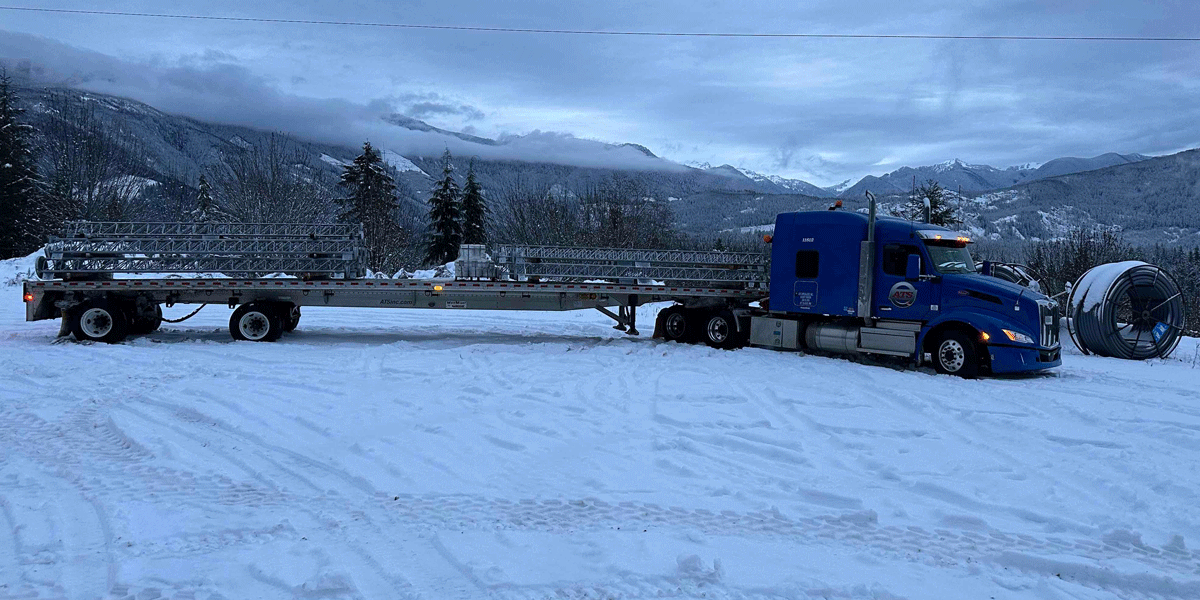Truck Driving in a Recession: An Honest Look at What’s Coming in 2023
Paul has spent nearly two decades in the transportation industry with roles in finance, operations, business transformation and risk management for companies with offerings in specialized flatbed, vans, brokerage, less-than-truckload (LTL), bulk, leasing, international and intermodal operations. He joined ATS in 2014 and serves as the chief financial officer.
It’s fairly safe to say that no one in the trucking industry is enjoying the uncertainty we’re facing with market conditions as we move from 2022 to 2023.
Customers, transportation providers, shippers and drivers alike are frustrated by the current market and what is potentially shaping up to be a recession in the new year.
As a truck driver, you’re no stranger to ups and downs in the market (unless you’re a new truck driver, in which case this might all be entirely new to you). You’ve dealt with changing freight rates and you’ve adapted your running style countless times to ensure you bring money home to your loved ones.
However, the market we’re dealing with now and heading into in 2023 is a little different than markets we’ve seen in the past. It’s hard to predict but there are a few things we know with certainty. The first thing is: You need to prepare yourself as best you can for what’s coming. Will rates continue to drop? How will your pay change?
ATS has been around for nearly seven decades and we’ve weathered countless peaks and valleys — all while guiding drivers to success.
Just as we have in the past — and will continue to do so in the future — we work to provide honest industry updates so you can adapt and make your business succeed no matter what comes your way. In this article, we’ll do the same thing by providing information on:
- Factors that led to the current soft market
- What to expect in 2023
- Tips for overcoming downturn market challenges
3 Factors Impacting the Trucking Industry Now and in 2023
You may be wondering how we’ve gotten ourselves into an unpredictable and unsettling economic situation in the U.S.
Let’s learn a little bit more about the key factors affecting today’s soft market and how they’ll continue to affect the industry in 2023.
Parts and Labor Shortages
As a truck driver, you’ve probably already directly felt the effects of the truck parts and labor shortages. Maybe you’ve been running older equipment or your truck has been in the shop for longer than usual because the part you needed to fix your truck was weeks out.
When rates skyrocket and peak, most carriers purchase new trucks. It’s believed that original equipment manufacturers (OEMs) need to produce between 225,000 and 250,000 trucks per year to keep up with replacement levels so older trucks can retire out of fleets. OEMs struggled to keep up with truck demand during the pandemic due to parts and labor shortages. Historically, we’re facing the biggest backlog of truck orders coming out of a peak period.
While the parts and labor shortages are no longer as bad as they were in 2021 and the start of 2022, and production levels are fairly stable now, OEMs won’t be able to produce above truck replacement levels to address the backlog.
New trucks will still be difficult to find and pricing on new trucks will continue to be inflated in 2023. Older trucks require more maintenance and are prone to more breakdowns — lease operators and owner-operators will see these costs directly.
Inflation
The pace of inflation has accelerated in the U.S. In September 2022, we hit a record high for inflation rates in 40 years. Inflation increased 0.4 percent in September, raising the Consumer Price Index (CPI) up 8.2 percent in just one year. We haven’t seen levels of inflation this high since August 1982. With inflation this high, everyone feels the strain.
The reason behind the high inflation? It’s a combination of global conflict, the COVID-19 pandemic and the ongoing parts and labor shortages.
The difference between the market we’re seeing now and the market we faced in the 1980s is that unemployment rates were high back then. Our unemployment rate is low today and labor participation has gone down. As such, it’s difficult to predict what the economy will look like in 2023.

A Shift in Consumer Spend
Consumer spend shifted during the pandemic. During the height of the pandemic, individuals were purchasing durable goods that were hauled on trucks. In 2022, that spending has shifted toward services. Think flights, hotels, restaurants and services. For drivers, that means there’s less freight available for them to haul.
As inflation has continued to rise, spending is starting to slow. Additionally, as the holidays approach, consumers are spending more on credit and less from their available cash. When bills come due in the early part of next year, buying could slow even further.
This is what the Federal Reserve is hoping for. They’ve been raising interest rates in the hopes that it will slow consumer spending and bring inflation down. With the inflation rate sitting at about 6.6 percent right now, they want to see it go back to around 2 percent.
As consumer spending slows, there will be less freight to haul on semi-trucks and spot rates will continue to stay low. In all likelihood, the U.S. will be facing a recession in early 2023.
How to Boost Driver Pay in 2023: 3 Tips
Spot rates have been dropping in recent months — edging closer to contract rate levels — but the cost to maintain equipment, support driver pay increases from the past two years and deal with higher fuel costs will dictate how low those rates can go. While that may mean spot rates have reached their floor, it doesn’t mean that driver struggles will end.
The challenge drivers like you are facing is likely to continue well into 2023. Is it time to quit the industry altogether? Not necessarily. There are strategies you can implement to keep yourself moving and turning a profit.
These three tips will help you succeed in 2023:
- Ensure you have a stable source of freight
- Implement fuel-efficient practices
- Keep a good maintenance schedule
#1: Ensure You Have a Stable Source of Freight
If you’re not working with a stable trucking company with a diverse freight base, now is the time to seek out that company. While job-hopping isn’t recommended, you may need to leave your current carrier to find one that’s more likely to last the economic difficulties predicted for 2023.
Companies with diverse customer bases that serve more than one type of industry or shipper will provide stability and keep you moving. As freight slows in one industry, it’ll pick up in another. For instance, if you’re working for a company that only hauls agriculture equipment, you’re going to be sitting for most of the winter. But if you work with a carrier who hauls freight for a wide variety of industries, you’ll always have freight to haul.
#2: Conserve Fuel
Fuel efficient practices — especially as a lease driver or owner-operator — are key as we head into 2023. With no significant decrease in sight for diesel prices, saving money at the pumps is top-of-mind. Some of it comes down to driver behavior — and some of it can be taken care of in the shop.
When you control your speed, limit aggressive driving, and use cruise control, you’ll see your miles-per-gallon (mpg) improve. Minor changes in the shop — like regular oil changes, fuel filter changes and a switch to synthetic oil — will also make a difference.
You’ll spend less overall when you take advantage of fuel discounts, only fuel for the load and drive fewer extra miles because you trip planned.
Avoiding excessive idle time can make a significant difference as well. No driver wants to freeze in the winter, so investing in a smarter solution like an inverter, bunk heater, auxiliary power unit (APU) or generator will keep you warm without requiring excess fuel consumption.
#3: Keep Up with Maintenance
Because of the truck shortage, trucks are on average one or two years older and have 100,000 to 200,000 more miles on them than usual. Preventative maintenance will help prevent costly breakdowns, so now is certainly not the time to skip those shop appointments.
When you’re in the shop for preventative maintenance, shop technicians will check fluid levels, tires, brakes, air filters and your battery. They’ll look over your entire truck to make sure it’s operating efficiently — which will save you at the pumps — and there are no potential issues. Their job is to catch issues at the shop before they become major, costly breakdowns out on the road.
Repairs on the road can not only cost two to four times what they normally would, but you can end up down for days — and even weeks — as you wait for parts to come in. Scheduling shop appointments for regular maintenance can go a long way in preventing these additional costs.
If you can, funnel money into your maintenance account regularly to cover any unforeseen repairs.
Succeed in 2023 and Beyond
While the forthcoming year doesn’t bring all good news, there are certainly ways you can overcome some of the main challenges coming your way. It helps to be prepared.
While you can’t fix parts and labor shortages, inflation and consumer spend, you can influence your fuel consumption and maintenance costs. If you don’t already work with a stable carrier, now is the time to find one. These are among the best carriers to work for in this market.
You can certainly change some of your habits on the road too. Keeping those wheels turning and running more miles will help you boost your pay and get it closer to pandemic pay levels. Opening up your ability to haul all sorts of freight will help you as we move into 2023.



